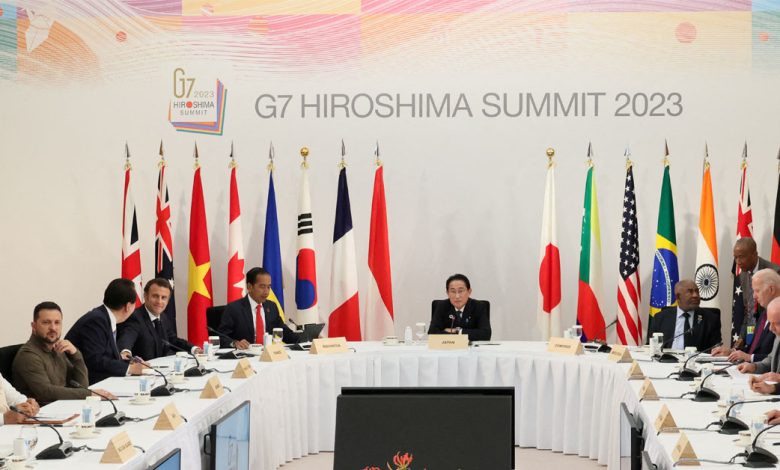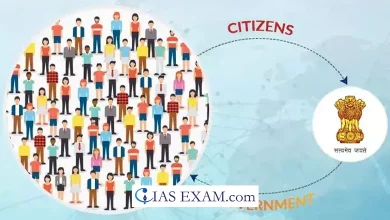
Context- During the new 49th G7 meeting, member countries had illustrated key achievements in their environment List of things to get because of progressing studies and reports that keep on raising cautions about the deteriorating condition of environmental change, asking quick activity.
Key Highlights
- In addition, the Indian Prime Minister unveiled a bust of Mahatma Gandhi in Hiroshima, Japan, at the same summit.
- In addition, the Quad Leaders’ Summit was held on the sidelines of the G7 summit and focused on initiatives for the Indo-Pacific region, shared democratic values, and strategic interests.
What are the G7’s primary climate goals?
- Global Emissions Peak by 2025:
-
-
- The need for a global emissions peak by 2025 was emphasized by the G7.
- Even though this is not required by the Paris Agreement, it is not impossible to achieve.
- Created nations are seeing a decrease in discharges, albeit not at the necessary speed while non-industrial nations’ outflows are as yet expanding.
- In the event that all nations just satisfy their current responsibilities, outflows in 2030 would be around 11% higher than 2010 levels.
-
- Getting Rid of Fossil Fuels:
-
-
- The G7 pledges to accelerate the phase-out of “unabated fossil fuels” in accordance with 1.5 degree Celsius trajectories, but does not specify a timetable for doing so.
- Without specifying the term “inefficient subsidies,” they plan to end “inefficient fossil fuel subsidies” by 2025 or earlier.
- Except in rare instances, the G7 states claim to have stopped funding new energy projects based on fossil fuels.
-
- Net-Zero Objectives:
-
- By 2050, the G7 will have reached net-zero emissions, and it encourages other major economies to do the same.
- The world in general should become net-zero by mid-century to meet the 1.5-degree Celsius target.
- India has set the date 2070 as its goal, while China wants to be net-zero by 2060.
- Major developing nations’ goals for the years after 2050 may shift in response to new technologies and the use of cleaner energy.
What are the Difficulties in Implementing the G7 Climate Wishlist?
-
- Deficient Activity and Irregularities:
- Despite accounting for 20% of global emissions, the G7 nations have not effectively carried out their commitments.
- Absence of adequate and steady activities to line up with the 1.5-degree Celsius and 2-degree Celsius temperature objectives.
- G7 part nations Inability to refresh nationally determined contributions (NDCs). Paris Understanding targets.
- Deficient Activity and Irregularities:
- Support for climate finance insufficient:
-
- Climate finance has been inadequately and slowly provided to developing nations in accordance with the Paris Agreement goals.
- Developing nations, which are disproportionately affected by the effects of climate change, require assistance with resilience and adaptation.
- According to Oxfam, in 2019, only 20% of climate finance from rich nations was allocated for adaptation, with the least amount reaching the least developed nations.
- Proceeded with Dependence on Petroleum derivatives:
- Analysis coordinated at the G7 nations for their continuous reliance on petroleum derivatives, especially coal.
- Fossil fuels, particularly coal, produce a lot of carbon, making climate change worse.
- Oil Change International points out that fossil fuel investments received more public funding than investments in clean energy from G7 nations.
For what reason did the PM of India Reveal Gandhi’s Bust in Hiroshima?
- One of the most influential leaders of the 20th century, Mahatma Gandhi stood for peace, non-violence, justice, and human dignity. As a tribute to his legacy and as a reminder of his significance in the world of today, his statue was unveiled at Hiroshima Peace Memorial Park.
- The G7 and its partners’ shared commitment to nuclear disarmament and non-proliferation and to preventing another nuclear catastrophe was the goal of the symbolic gesture.
- It was likewise intended to recognize the misery and flexibility of the Hibakusha, the overcomers of the nuclear bombings of Hiroshima and Nagasaki in 1945.
- The sculpture was likewise viewed as an acknowledgment of India’s job and commitment to worldwide harmony and security, as well as its organization with Japan on different issues, including environmental change.
- The leaders of the G7 and the Indian Prime Minister, who was invited to the summit as a guest along with leaders from Australia, South Korea, and South Africa, attended the unveiling ceremony.
What Were the Outcomes of the Quad Leaders’ Summit?
- The Quad Leaders’ Summit was hung on May 23, 2023, on the sidelines of the G7 summit. It was attended by the President of India, President Joe Biden of the US, Prime Minister Scott Morrison of Australia and Prime minister Yoshihide Suga of Japan.
- The Quad is an informal strategic dialogue between four democracies in the Indo-Pacific who share common values and interests.
- Climate change is a key area of cooperation among the Quad members. The pioneers gave a joint explanation that reaffirmed their obligation to the Paris Understanding and its full execution.
- Additionally, they announced a number of initiatives to enhance cooperation in the areas of innovation, adaptation, resilience, and the transition to clean energy. These initiatives include:
- establishing a brand-new Quad Climate Working Group to coordinate their efforts on national and international climate policy.
- Laying out a Quad Clean Energy Partnership to help the sending of clean energy innovations in Indo-Pacific nations through specialized help, limit building, and supporting systems.
- Providing support to a Quad Green Shipping Network to encourage the decarbonization of maritime transportation through the development of standards, the sharing of best practices, and information.
- Growing collaboration on catastrophe risk decrease and the board through joint activities, preparing, and data sharing.
- Supporting nature-based answers for environment moderation and variation through the protection and reclamation of biological systems like woodlands, wetlands, and mangroves.
What is the G7?
- Established in 1975, it is an intergovernmental organization.
- The group meets every year to discuss topics like energy policy, international security, and global economic governance, all of which are of mutual interest.
- The United Kingdom, Canada, France, Germany, Italy, Japan, and the United States make up the G7.
- The G20 includes India as well as all of the G7 nations.
- There is neither a secretariat nor a formal charter for the G7. The administration, which pivots among part nations every year, is accountable for setting the plan. Sherpas, priests and emissaries work out arrangement drives before the highest point.
- Hiroshima, Japan, was the location of the 49th G7 summit.





.png)



